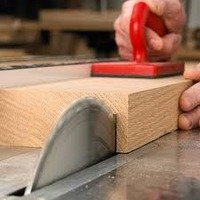Table Saw Initiative
/October 2011
by Michael Showalter
 After years of allowing the power tool industry to police itself through voluntary standards, the Consumer Product Safety Commission (CPSC) is calling on toolmakers to strengthen safety standards. These actions come as table saw manufacturers face an increasing number of product safety lawsuits throughout the country. One of those lawsuits resulted in a jury awarding $1.5 million to a man who had sawed his fingers on a Ryobi brand table saw. In that lawsuit the plaintiffs charged that the manufacturer had known about a safety technology called SawStop, but had not integrated it (or something similar) to its products. No less than 50 similar lawsuits are pending nationwide, putting manufacturers on the defensive. Every day 10 people lose fingers in table saw amputations and the chairman of the CPSC would like to know why more isn't being done to prevent such accidents.
After years of allowing the power tool industry to police itself through voluntary standards, the Consumer Product Safety Commission (CPSC) is calling on toolmakers to strengthen safety standards. These actions come as table saw manufacturers face an increasing number of product safety lawsuits throughout the country. One of those lawsuits resulted in a jury awarding $1.5 million to a man who had sawed his fingers on a Ryobi brand table saw. In that lawsuit the plaintiffs charged that the manufacturer had known about a safety technology called SawStop, but had not integrated it (or something similar) to its products. No less than 50 similar lawsuits are pending nationwide, putting manufacturers on the defensive. Every day 10 people lose fingers in table saw amputations and the chairman of the CPSC would like to know why more isn't being done to prevent such accidents.
 Most table saw operators who injured themselves removed the blade guard for operational convenience, according to a CPSC study conducted from 2007 to 2008 that looked at 66,900 "blade contact injuries." For that reason, CPSC is considering requiring that table saws come with a safety brake like the one offered on SawStop contractor and cabinet table saws, according to NPR. Within three-thousands of a second of contacting human skin, the brake fires and the blade drops down into the table, preventing injury.
Most table saw operators who injured themselves removed the blade guard for operational convenience, according to a CPSC study conducted from 2007 to 2008 that looked at 66,900 "blade contact injuries." For that reason, CPSC is considering requiring that table saws come with a safety brake like the one offered on SawStop contractor and cabinet table saws, according to NPR. Within three-thousands of a second of contacting human skin, the brake fires and the blade drops down into the table, preventing injury.
SawStop detects flesh and almost instantly stops the saw blade from spinning and drops it into the tool and away from fingers and hands. In demonstrations using hot dogs, the technology has been shown to leave nothing more serious than a small nick on the skin. CPSC says it costs the United States $35,000 every time someone is injured on a table saw, accounting for medical treatment, lost time from work, product liability & litigation, and human pain and suffering, so the CPSC is working to implement tighter safety standards for the common contractor tool.
However, cost is the main sticking point for requiring a blade brake like SawStop on every table saw sold in the U.S. Most manufacturers say it would add $100-$200 to the price of a new table saw. For a small portable or jobsite unit, that could double the current sales price. As a first step to making the law, CPSC recently recommended publishing an Advanced Notice of Proposed Rulemaking in the Federal Register. After that, public comment is sought before crafting a final rule.
Contractors must be prepared to provide the correct power equipment on all sites if and when the new rules for table saws are adopted. Otherwise they may face liability for providing an unsafe work place and endangering workers. The Washington Administrative Code regarding equipment can be found at this website: